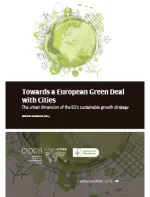Introduction. Towards a European Green Deal with Cities

The European Union (EU) is widely considered a global leader in climate action. Yet, until the launch of the European Green Deal (EGD) in December 2019, it had no comprehensive policy framework to tackle climate change and the transition towards more sustainable development. Proclaimed Europe’s “man on the moon moment” by the then newly appointed Commission President Ursula von der Leyen, the EGD aspires to provide such a framework, leading the EU to become the first continent to cut its emissions to net zero by 2050.
The EGD has been promoted as the EU’s post-2020 growth strategy, which will drive the bloc’s transition to a competitive green and circular economy that is decoupled from non-reAnewable resource use. But the initiative’s ambitions and the climate and ecological risks at stake make it more than just another growth strategy. As the EGD roadmap states, the goal is to draw up “deeply transformative policies” that mainstream sustainability and climate action in all EU policies and programmes (EC, 2019a). In other words, the EGD aspires to foster long-term systemic change. This will not only require significant macro-level economic, infrastructural and technological innovation, but also micro-adaptations in lifestyles, behaviour and consumption patterns. Such change will also depend on a political and organisational evolution of public administration, away from traditional silo-based working cultures and towards a more cross-cutting and citizen-driven way of operating.